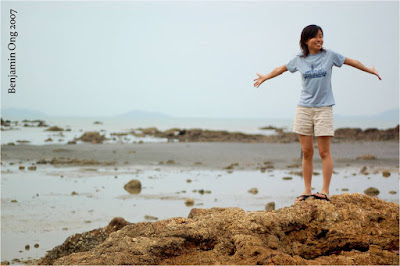What's with politics in Malaysia?
The Economist's take on Anwar Ibrahim, 'Malaysia's Chameleon':
http://www.economist.com/world/asia/displaystory.cfm?story_id=14140818
I think we're in for a ridiculous Saturday tomorrow.
Lim Kit Siang is calling for Datuk Liow Tiong Lai's resignation as Health Minister for apparent failure to contain the H1N1 situation in Malaysia. However, there have been only 4 deaths following 1,302 confirmed cases, all of which were partly caused by other complications like diabetes.
At any rate, if Kit Siang is really interested in containing the virus, he should vehemently call for the cancellation of the anti-ISA rally planned for tomorrow afternoon. Large crowds are great opportunities for the spread of viruses.
I'm no Government butt-kisser, but it seems we have an Opposition with double standards, no?
Anyway, I'm supposed to accompany this professor on a guided tour of Rimba Ilmu, UM's Botanic Garden tomorrow.
Also, it's the VI's Speech (prize-giving) Day tomorrow.
Looks like I'll be putting my life and time to better use than some of these idiots who just want publicity.
Friday, July 31, 2009
Monday, July 27, 2009
Sunday, July 26, 2009
MLK and Yasmin
"I still believe that standing up for the truth of God is the greatest thing in the world. This is the end of life. The end of life is not to be happy. The end of life is not to achieve pleasure and avoid pain. The end of life is to do the will of God, come what may."
--Martin Luther King, Jr.
(From Tentmaker.org, quoted in today's church bulletin)
* * *
At the end of Yasmin Ahmad's Gubra is a parallel scene in which a father and son are kneeling in church, reciting the Lord's Prayer, and a mother and daughter (I think), clad in telekung and reciting prayers.
At least, I think it is the Lord's Prayer. I remember only the phrase, "Father, forgive us."
I was having lunch with a friend--it could have been Ai Wei--in KPS, and she asked if it was Gubra, saying it has a very Yasmin Ahmad-like feel. It was my first glance at Gubra, and the memory is still very vivid.
Yasmin was good at parallels, showing that Malaysia remains united because at the heart of it there are more things that unite us than things that divide us. And these things that unite are not the stuff of government (or opposition) propaganda, but things like the cries of repentance and forgiveness that echo across the Muslim-Christian divide.
It is reported that she died of bleeding in her brain. If we could see the colour of that blood, and if we could somehow bleed with her also, we would see that we all bleed the same red blood.
I'd like to think that she would have wanted that to be a lesson, that when we call for the blood of another Malaysian, we are truly calling only for our own blood.
I do not know how she felt or what she was thinking in the hours before she slipped out of consciousness, but she stood up for the truth of God, alright. And when she meets Martin Luther King, Jr, I think they would have quite a bit to talk about.
We are a fragmented country, and even our flag may be interpreted along such lines.
We have a sharp star, like the durian--the aroma of heaven to some, the stench of death to others. Is it not true of us, that we Malaysians are so good at hurting and poking one another?
We have a moon that is not full, but just barely a sliver of light. Almost as if the choice is in our hands, if we should allow the light to shine more brightly, or if we should snuff it out.
Red and white stripes. Sacrifice and holiness, the highest calling of the Christian life, perhaps even the most enduring pillars of all religion and faith throughout the centuries.
Rest in peace, Yasmin. There may be hope yet for Malaysia. Your movies set things in motion, got people talking. I suspect we will see DVDs surface, and perhaps some of them may be rerun in local cinemas. We can only hope that the seeds you planted will reap a blessed future.
There may be hope yet.
--Martin Luther King, Jr.
(From Tentmaker.org, quoted in today's church bulletin)
* * *
At the end of Yasmin Ahmad's Gubra is a parallel scene in which a father and son are kneeling in church, reciting the Lord's Prayer, and a mother and daughter (I think), clad in telekung and reciting prayers.
At least, I think it is the Lord's Prayer. I remember only the phrase, "Father, forgive us."
I was having lunch with a friend--it could have been Ai Wei--in KPS, and she asked if it was Gubra, saying it has a very Yasmin Ahmad-like feel. It was my first glance at Gubra, and the memory is still very vivid.
Yasmin was good at parallels, showing that Malaysia remains united because at the heart of it there are more things that unite us than things that divide us. And these things that unite are not the stuff of government (or opposition) propaganda, but things like the cries of repentance and forgiveness that echo across the Muslim-Christian divide.
It is reported that she died of bleeding in her brain. If we could see the colour of that blood, and if we could somehow bleed with her also, we would see that we all bleed the same red blood.
I'd like to think that she would have wanted that to be a lesson, that when we call for the blood of another Malaysian, we are truly calling only for our own blood.
I do not know how she felt or what she was thinking in the hours before she slipped out of consciousness, but she stood up for the truth of God, alright. And when she meets Martin Luther King, Jr, I think they would have quite a bit to talk about.
We are a fragmented country, and even our flag may be interpreted along such lines.
We have a sharp star, like the durian--the aroma of heaven to some, the stench of death to others. Is it not true of us, that we Malaysians are so good at hurting and poking one another?
We have a moon that is not full, but just barely a sliver of light. Almost as if the choice is in our hands, if we should allow the light to shine more brightly, or if we should snuff it out.
Red and white stripes. Sacrifice and holiness, the highest calling of the Christian life, perhaps even the most enduring pillars of all religion and faith throughout the centuries.
Rest in peace, Yasmin. There may be hope yet for Malaysia. Your movies set things in motion, got people talking. I suspect we will see DVDs surface, and perhaps some of them may be rerun in local cinemas. We can only hope that the seeds you planted will reap a blessed future.
There may be hope yet.
Saturday, July 25, 2009
Glances

Sometimes it's slow going
But there's a knowing
That someday, perfect I will be.

Laughing gas on Yen's 23rd.

The Vice Chancellor officiated at the opening of the Cultural Centre's art exhibition, 'Hijau', which runs till 30 July at Dewan Tunku Canselor, University of Malaya.
Instead of cutting a ribbon, he splashed some acrylic on canvas.

Dr Sabzali, who recently joined the Cultural Centre, showing the VC around. He is the curator of the exhibition.
In the background is Dr Solehah Ishak, director of the Cultural Centre.

The cross connects these
Fragile, empty shells of variable memory
To the source of great (electrical) power
That the little LEDs may shine.
Jesus Christ connects us
Frail, empty shells of shallow depth
To the source of inexhaustible power
That our little lights may shine for him.
Impromptu: 731
Do or die, we try
To educate that we may love
And not hate.
Fail to breathe, seek release,
Sing, dance, kill yourself
And only tell your confidants.
Much afraid, this grand parade
With lights and sounds--
I trip over and fall into the darkness
Around. Stage fright.
Free to live, I don't believe
Life is that cheap.
Leap of faith, human or wraith
I do not know.
God will show the way to go
Through the shifting shadows of the night.
(They say He is not like that.)
Screech of owl, cry of bat,
Hyena cackle, human howl, this or that.
Around the cave, only a cat
But the monsters have left.
Right or wrong, right a wrong,
Ours is the cross and the narrow way.
Sharpen your arrow, don't get lost,
Keep silence till the break of day;
Be still, my soul, within me.
Lever and trough, phantoms of you,
One blow unto the vestal's chest;
Fever and cough, symptoms of flu,
Two flew over the bulbul's nest.
Enough, now, get some rest.
* * *
On another note, so much for Wikipedia's credibility.
I am so going to read the article with two heaped tablespoons of salt.

To educate that we may love
And not hate.
Fail to breathe, seek release,
Sing, dance, kill yourself
And only tell your confidants.
Much afraid, this grand parade
With lights and sounds--
I trip over and fall into the darkness
Around. Stage fright.
Free to live, I don't believe
Life is that cheap.
Leap of faith, human or wraith
I do not know.
God will show the way to go
Through the shifting shadows of the night.
(They say He is not like that.)
Screech of owl, cry of bat,
Hyena cackle, human howl, this or that.
Around the cave, only a cat
But the monsters have left.
Right or wrong, right a wrong,
Ours is the cross and the narrow way.
Sharpen your arrow, don't get lost,
Keep silence till the break of day;
Be still, my soul, within me.
Lever and trough, phantoms of you,
One blow unto the vestal's chest;
Fever and cough, symptoms of flu,
Two flew over the bulbul's nest.
Enough, now, get some rest.
* * *
On another note, so much for Wikipedia's credibility.
I am so going to read the article with two heaped tablespoons of salt.

Friday, July 17, 2009
A few last thoughts
"For I too am a man under authority," he said.
Perhaps what was so praiseworthy about this man, was that he was a servant of the most powerful empire the world had ever seen, and yet he knew that, in Jesus, a greater authority than Caesar's was present.
He believed that Jesus could dispense with demons and disease in the same way a superior Roman officer could dispense with his subordinates. Caesar might have been king of the world, but Jesus was the Lord of the Universe.
Maybe that is faith: knowing our place, and trusting that God knows His, and acting accordingly.
* * *
You sent.
Vlad Trabant.
Snow White.
But I did not listen.
Perhaps what was so praiseworthy about this man, was that he was a servant of the most powerful empire the world had ever seen, and yet he knew that, in Jesus, a greater authority than Caesar's was present.
He believed that Jesus could dispense with demons and disease in the same way a superior Roman officer could dispense with his subordinates. Caesar might have been king of the world, but Jesus was the Lord of the Universe.
Maybe that is faith: knowing our place, and trusting that God knows His, and acting accordingly.
* * *
You sent.
Vlad Trabant.
Snow White.
But I did not listen.
Wednesday, July 15, 2009
Before the cleaning of the lens

There was nothing special about that day.
It rained outside the coffee shop, in a very usual Malaysian way.
There was nothing special about that day.
A rush of joy, a surge of youth, in the usual camera play.
There was nothing special about that day.
A million kids, nearly as many doctors and nurses. Fathers
and mothers, and the happily-ever-afters.
What was so special about that day?
I don't know; I was yet to be.
But you were, ahead of me.
Have a blessed one, Yen. ;-)
Tuesday, July 14, 2009
Back at the Beginning
"Welcome to the Lord's table," said Pastor Linda as she presided over Communion in church last Sunday (5 July). I have sat through many a Communion service, but on that Sunday the invitation felt warmer and more immediate than anything I'd heard in a long while.
Maybe it was the irony of it all, for I have been anywhere but near the Lord, and thus to be welcome at his table felt bitterly unreal. The bread should have choked me, and the wine finish me off by poisoning. But none of that happened.
I moved back into college that day, for the third consecutive year. I'm staying in the very same room that welcomed me into the University of Malaya in June 2007. Dad and Kevin helped me carry my things to my room, while Mum and Sara waited with Ah Kong downstairs.
It was Ah Kong's first time stepping into my college, I think, and it felt like my first time too. Just the week before, I was busy with the Orientation as a member of the Student Council, but on that Sunday it felt as if I were checking in on a clean slate, a blank draft.
I miss the girls who saw me through my first and second years.
* * *

At the KL Gate, after Council duty handing out maps of the campus to the newcomers.
My parents gave me the bicycle for my 21st birthday, but an accident in early August last year kept me out of bicycle action for a few months. I started riding again earlier this year, but this is the first photograph of me and my new friend. Thanks, Tim!
(And no, Ai Wei, I still don't have a name for the bike!)

Sometimes the road less travelled is the only road to travel.
Thanks, Jon. And thanks, Joy.

Just because.
Life can be sweet in spite of the bitterness of working with some people, in spite of the pain that comes from loving the society in which we live while wondering if it knows what on earth it is doing to itself.
Father, forgive us.

Life is colourful!
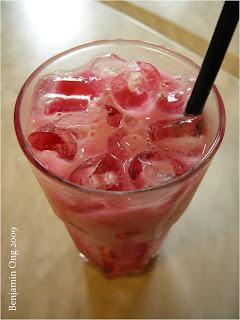
Sirap bandung. The drink that started it all.
It was good to be reminded at lunch, just before returning to college.
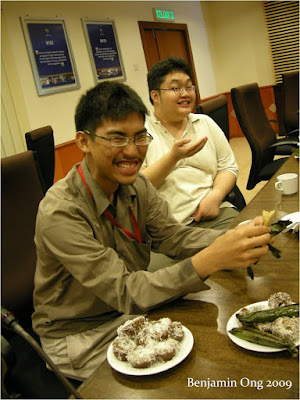
Freeloading. (Was this what the votes were worth?)

I brought back a leftover fish from the dissection exercise, and got the guys at Sahur (my college's 'mamak' café) to fry it for supper.
And then there was Amos's Milicks ais, which became, much to his amusement, Horlicks topped off with Milo powder.

Jia Hua hiding behind Li Ern's legacy. It was nice to see that old clipboard at the first PKV meeting of the year!
* * *
The other day, talking to Fang Hai, Kuhan and Jon, we realised that Michael Jackson was really the epitome of, and perhaps the closest a pop star would ever get, to the word 'artist'.
As I mull over his life (and death), I think one of the reasons why he was such a big hit was that he created a space in which all kinds of people from all walks of life could participate. His was a stage on which just about anyone could dance.
I remember what some people said, that he did a better job of bringing people together than any politician or government has in recent history (maybe even in all of history).
As I enter my third year here, the path I have chosen to walk seems more and more to be forking into two linked yet distinct destinies: to be an environmental activist, or to be a research zoologist? Easiest answer: why not do both?
I've noticed that, with all the international hype about conservation and climate change, it's easy for ecology students to be pigeon-holed. We're the 'green people', the tree huggers, turtle cuddlers, whatever.
But the thing is, I never set out to convert the world into little green men and women. At times I think my idea of a 'green' society is not what the world wants. Everyone's talking about energy-efficient cars; I say we should walk more! Forget about biodegradable plastic bags; just say 'no' at the cashier's counter.
The joke is told of the Americans who realised conventional pens could not work in outer space (zero gravity) and therefore spent billions inventing a pen that could. The Russians, being more backward and poor, used pencils instead. Go figure.
Moral of the story: the best solutions for planet Earth are not expensive or 'hi-tech'. They are in fact the oldest ways, the most traditional and conventional practices; they way forward is the way of common sense, not Al Gore sense or whatever. But many don't have this common sense.
So, back to the dilemma. I set out to do this because I love biology, because the natural world fascinates me, because I've always been spellbound by God's creation in all its diversity and splendour. One doesn't need a degree in Ecology and Biodiversity in order to be an effective catalyst for environmental change; a passionate lawyer, accountant or musician could do just as well, if not better.
It would be great if I can be an eminent zoologist as well as a leading activist. But at this point in time, it appears I only have enough energy for one or the other.
Thing is, sometimes I think I've gotten confused with the picture others have of me. Many think I like politics; on the strength of their support and votes, I'm here in the Student Council, though I do not feel the part at all. Many think I am an environmentalism nut: fool me once, shame on you; fool me twice, shame on me.
I'm not going to fall into that trap of becoming an environmental activist just because people think I fit the role, or because society thinks it's important, or because that's all the rage now. I'm going to focus on the actual learning and the work that began when Adam named the animals, and which continues today in the post-Darwinian matrix.
It's called passion. It's the stuff you see in Billie Jean, in Bad, in Thriller, in Black or White, in Beat It. It's almost impossible to pin down, but when it's in the room, everything else just fades to shadowy shades of grey.
Maybe it was the irony of it all, for I have been anywhere but near the Lord, and thus to be welcome at his table felt bitterly unreal. The bread should have choked me, and the wine finish me off by poisoning. But none of that happened.
I moved back into college that day, for the third consecutive year. I'm staying in the very same room that welcomed me into the University of Malaya in June 2007. Dad and Kevin helped me carry my things to my room, while Mum and Sara waited with Ah Kong downstairs.
It was Ah Kong's first time stepping into my college, I think, and it felt like my first time too. Just the week before, I was busy with the Orientation as a member of the Student Council, but on that Sunday it felt as if I were checking in on a clean slate, a blank draft.
I miss the girls who saw me through my first and second years.
* * *

At the KL Gate, after Council duty handing out maps of the campus to the newcomers.
My parents gave me the bicycle for my 21st birthday, but an accident in early August last year kept me out of bicycle action for a few months. I started riding again earlier this year, but this is the first photograph of me and my new friend. Thanks, Tim!
(And no, Ai Wei, I still don't have a name for the bike!)

Sometimes the road less travelled is the only road to travel.
Thanks, Jon. And thanks, Joy.

Just because.
Life can be sweet in spite of the bitterness of working with some people, in spite of the pain that comes from loving the society in which we live while wondering if it knows what on earth it is doing to itself.
Father, forgive us.

Life is colourful!

Sirap bandung. The drink that started it all.
It was good to be reminded at lunch, just before returning to college.

Freeloading. (Was this what the votes were worth?)

I brought back a leftover fish from the dissection exercise, and got the guys at Sahur (my college's 'mamak' café) to fry it for supper.
And then there was Amos's Milicks ais, which became, much to his amusement, Horlicks topped off with Milo powder.

Jia Hua hiding behind Li Ern's legacy. It was nice to see that old clipboard at the first PKV meeting of the year!
* * *
The other day, talking to Fang Hai, Kuhan and Jon, we realised that Michael Jackson was really the epitome of, and perhaps the closest a pop star would ever get, to the word 'artist'.
As I mull over his life (and death), I think one of the reasons why he was such a big hit was that he created a space in which all kinds of people from all walks of life could participate. His was a stage on which just about anyone could dance.
I remember what some people said, that he did a better job of bringing people together than any politician or government has in recent history (maybe even in all of history).
As I enter my third year here, the path I have chosen to walk seems more and more to be forking into two linked yet distinct destinies: to be an environmental activist, or to be a research zoologist? Easiest answer: why not do both?
I've noticed that, with all the international hype about conservation and climate change, it's easy for ecology students to be pigeon-holed. We're the 'green people', the tree huggers, turtle cuddlers, whatever.
But the thing is, I never set out to convert the world into little green men and women. At times I think my idea of a 'green' society is not what the world wants. Everyone's talking about energy-efficient cars; I say we should walk more! Forget about biodegradable plastic bags; just say 'no' at the cashier's counter.
The joke is told of the Americans who realised conventional pens could not work in outer space (zero gravity) and therefore spent billions inventing a pen that could. The Russians, being more backward and poor, used pencils instead. Go figure.
Moral of the story: the best solutions for planet Earth are not expensive or 'hi-tech'. They are in fact the oldest ways, the most traditional and conventional practices; they way forward is the way of common sense, not Al Gore sense or whatever. But many don't have this common sense.
So, back to the dilemma. I set out to do this because I love biology, because the natural world fascinates me, because I've always been spellbound by God's creation in all its diversity and splendour. One doesn't need a degree in Ecology and Biodiversity in order to be an effective catalyst for environmental change; a passionate lawyer, accountant or musician could do just as well, if not better.
It would be great if I can be an eminent zoologist as well as a leading activist. But at this point in time, it appears I only have enough energy for one or the other.
Thing is, sometimes I think I've gotten confused with the picture others have of me. Many think I like politics; on the strength of their support and votes, I'm here in the Student Council, though I do not feel the part at all. Many think I am an environmentalism nut: fool me once, shame on you; fool me twice, shame on me.
I'm not going to fall into that trap of becoming an environmental activist just because people think I fit the role, or because society thinks it's important, or because that's all the rage now. I'm going to focus on the actual learning and the work that began when Adam named the animals, and which continues today in the post-Darwinian matrix.
It's called passion. It's the stuff you see in Billie Jean, in Bad, in Thriller, in Black or White, in Beat It. It's almost impossible to pin down, but when it's in the room, everything else just fades to shadowy shades of grey.
Monday, July 13, 2009
Film vs Digital
Exactly a month ago, a few d'NAers invaded the sleepy, peaceful town of Kuala Pilah.
Yen wrote about it very promptly, here. My side of the story will be coming very soon.
Meanwhile, I was looking through the pictures, and realised Ken Rockwell is right about a few things when it comes to the film-digital divide.
I'm comparing the following pictures, one shot on film and scanned in at about 2.7 megapixels, the other shot at 5.0 megapixels on a Canon Powershot digital compact camera.
The pictures have not been edited beyond very mild brightness adjustments and square cropping.
In this comparison, I will ignore exposure, i.e. brightness, as they were shot at different settings. But there are a few little elements which are consistent from digital compact to digital SLR, and these are the ones I will discuss.
Big Picture
.jpg)
d'NAers in front of Desa Inn, Kuala Pilah. Canon Powershot A720 IS.
.jpg)
d'NAers in front of Desa Inn, Kuala Pilah. Nikon FM10 with 50mm f1.8 lens, Fujichrome Velvia 50.
Dark Colours
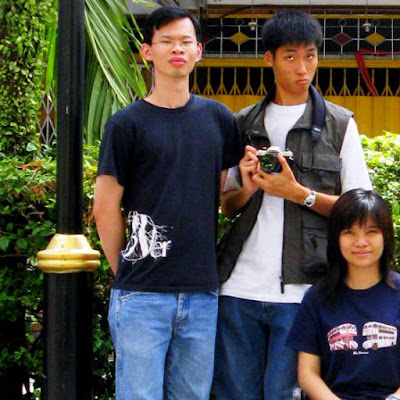
Digital.

Film.
Notice that there is noise on David's navy T-shirt in the digital shot, and grain in the film. Velvia 50 is a practically grainless film, and the grain is visible only because this is a 100% crop from a low-resolution 2.7 megapixel scan. In fact, Velvia can be scanned up to 24 megapixels on a good scanner.
But the point is that grain does not affect colour fidelity, unlike noise, which throws in random bits of colour in dark areas of a photograph. This is common in pictures shot under low light, but should not happen in a photo taken in broad daylight, such as this.
Digital SLRs, because of their larger sensors (compared to digital compacts), are able to better maintain the integrity of dark areas, but as this test shows, even the best digital SLRs have their limitations.
Film, on the other hand, knows no bounds because it does not rely on individual pixels to relay information. (Go look up Bayer interpolation to know why digital will always be one or more steps behind.)
Colours and Highlights
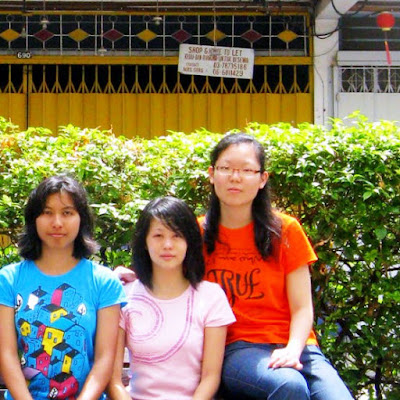
Digital.

Film.
First, colour. The Powershot was set to Vivid mode (Yen's default), and Velvia is always vivid. But notice that while Ming's T-shirt is a lot more saturated (bright orange) in the digital picture than in the film, the red lanterns in the background are more saturated in the film.
Film has more even colour saturation, though digital SLRs do come a lot closer than digital compacts.
Second, highlight control. In the digital shot, there is a greater disparity between the dark areas (shophouse shutters) and bright areas (e.g. Alissa's left shoulder) than in the film shot.
Once again, a digital SLR would have done a better job in maintaining the highlights (really bright areas) while bringing out the shadows. But nothing tops film.
Sharpness and Detail
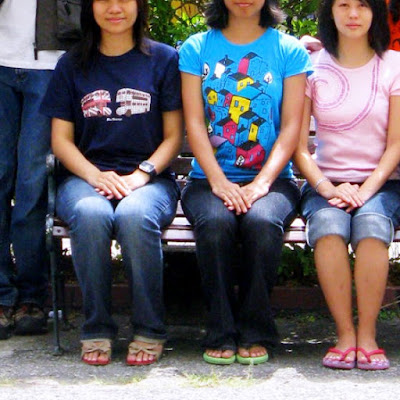
Digital.
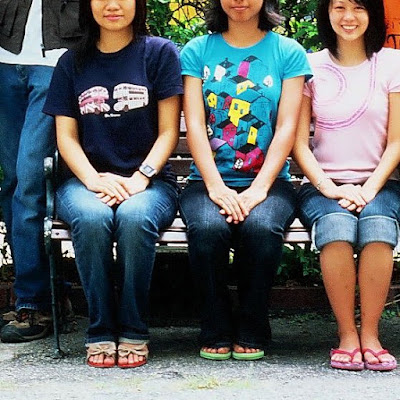
Film.
Look at the jeans and slippers. I rest my case. There is so much more detail, texture and depth in the film shot.
Digital (whether SLR or compact) always looks cleaner because it cheats on noise. Most modern digital cameras employ noise reduction, which gets rid of the coloured bits of noise in dark areas. However, this also wipes out the texture that was on the original subject.
Film has no noise reduction, because it has no noise to begin with. Film is comprised of photosensitive crystals which appear as grain, and grain always keeps the texture in there. It is the equivalent of art block in watercolour painting, which always has a rougher texture than inkjet prints of billboard advertisements and movie posters.
Digital always has a more two-dimensional, cartoon-y look, while film is a lot more three-dimensional. This is not at all to say that digital is worse than film; they are different media in the same way that watercolour and oil are different media.
In our digital inkjet age, clean, crisp photographs are held to be the standard. But as someone with an art background, I seek more texture and punch in my photographs; something film never fails to deliver, and digital cannot.
So what am I against? Digital photography? Not at all. I own and shoot a digital SLR, and I still love it.
What I find hilarious are the countless advertisements that seemingly assert the superiority of the latest digital SLR or compact over all prior models. What they don't disclose is that film has always been way superior in terms of technical quality; digital only makes things more convenient, especially for amateurs like myself who are wont to make mistakes.
Go ahead, shoot digital; it's a whole lot more fun. But once in a while, it's nice to pop a couple of rolls of film, if only to be reminded of what photography was, and is, in the first place.
Yen wrote about it very promptly, here. My side of the story will be coming very soon.
Meanwhile, I was looking through the pictures, and realised Ken Rockwell is right about a few things when it comes to the film-digital divide.
I'm comparing the following pictures, one shot on film and scanned in at about 2.7 megapixels, the other shot at 5.0 megapixels on a Canon Powershot digital compact camera.
The pictures have not been edited beyond very mild brightness adjustments and square cropping.
In this comparison, I will ignore exposure, i.e. brightness, as they were shot at different settings. But there are a few little elements which are consistent from digital compact to digital SLR, and these are the ones I will discuss.
Big Picture
.jpg)
d'NAers in front of Desa Inn, Kuala Pilah. Canon Powershot A720 IS.
.jpg)
d'NAers in front of Desa Inn, Kuala Pilah. Nikon FM10 with 50mm f1.8 lens, Fujichrome Velvia 50.
Dark Colours

Digital.

Film.
Notice that there is noise on David's navy T-shirt in the digital shot, and grain in the film. Velvia 50 is a practically grainless film, and the grain is visible only because this is a 100% crop from a low-resolution 2.7 megapixel scan. In fact, Velvia can be scanned up to 24 megapixels on a good scanner.
But the point is that grain does not affect colour fidelity, unlike noise, which throws in random bits of colour in dark areas of a photograph. This is common in pictures shot under low light, but should not happen in a photo taken in broad daylight, such as this.
Digital SLRs, because of their larger sensors (compared to digital compacts), are able to better maintain the integrity of dark areas, but as this test shows, even the best digital SLRs have their limitations.
Film, on the other hand, knows no bounds because it does not rely on individual pixels to relay information. (Go look up Bayer interpolation to know why digital will always be one or more steps behind.)
Colours and Highlights

Digital.

Film.
First, colour. The Powershot was set to Vivid mode (Yen's default), and Velvia is always vivid. But notice that while Ming's T-shirt is a lot more saturated (bright orange) in the digital picture than in the film, the red lanterns in the background are more saturated in the film.
Film has more even colour saturation, though digital SLRs do come a lot closer than digital compacts.
Second, highlight control. In the digital shot, there is a greater disparity between the dark areas (shophouse shutters) and bright areas (e.g. Alissa's left shoulder) than in the film shot.
Once again, a digital SLR would have done a better job in maintaining the highlights (really bright areas) while bringing out the shadows. But nothing tops film.
Sharpness and Detail

Digital.

Film.
Look at the jeans and slippers. I rest my case. There is so much more detail, texture and depth in the film shot.
Digital (whether SLR or compact) always looks cleaner because it cheats on noise. Most modern digital cameras employ noise reduction, which gets rid of the coloured bits of noise in dark areas. However, this also wipes out the texture that was on the original subject.
Film has no noise reduction, because it has no noise to begin with. Film is comprised of photosensitive crystals which appear as grain, and grain always keeps the texture in there. It is the equivalent of art block in watercolour painting, which always has a rougher texture than inkjet prints of billboard advertisements and movie posters.
Digital always has a more two-dimensional, cartoon-y look, while film is a lot more three-dimensional. This is not at all to say that digital is worse than film; they are different media in the same way that watercolour and oil are different media.
In our digital inkjet age, clean, crisp photographs are held to be the standard. But as someone with an art background, I seek more texture and punch in my photographs; something film never fails to deliver, and digital cannot.
So what am I against? Digital photography? Not at all. I own and shoot a digital SLR, and I still love it.
What I find hilarious are the countless advertisements that seemingly assert the superiority of the latest digital SLR or compact over all prior models. What they don't disclose is that film has always been way superior in terms of technical quality; digital only makes things more convenient, especially for amateurs like myself who are wont to make mistakes.
Go ahead, shoot digital; it's a whole lot more fun. But once in a while, it's nice to pop a couple of rolls of film, if only to be reminded of what photography was, and is, in the first place.
Monday, July 06, 2009
Glimpses of May and June 2009
A lot of things happened over the holidays which ended yesterday. Many photos were taken, but only a few will be shared here. Perhaps some experiences do not require verbose expositions.
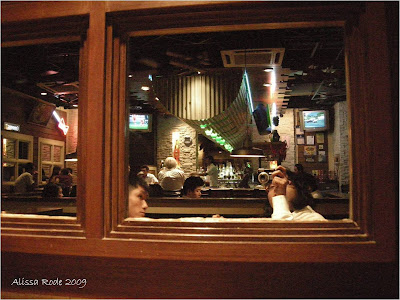
26 May: Met up with Alissa for the second time, having picked her up from the Bangsar LRT station the day before. She was on the lookout for a digital compact camera; she has since decided on the RM1300 Fujifilm Finepix F200EXR, having at first considered it too pricey.
I generally recommend Canon cameras, but I think the Finepix F200EXR is easily the most promising digital compact around today. Of course, digital cameras come and go with more randomness than Malaysian politician deaths, so the best today may easily be superseded a few months down the road.
Film is still the best investment, if quality is paramount.
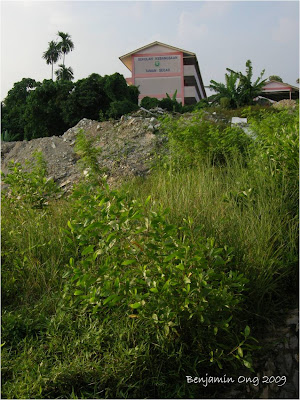
29 May: My primary school, Sekolah Kebangsaan Taman Segar. The place has since surrendered its serenity to the hustle and bustle of development.
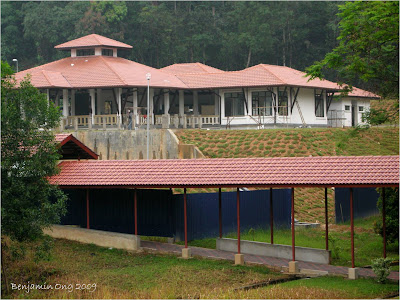
2 June: The new café at the Faculty of Science. It is coming along well, but Fitrah and I think it is way to small to cater to the faculty's colossal population.
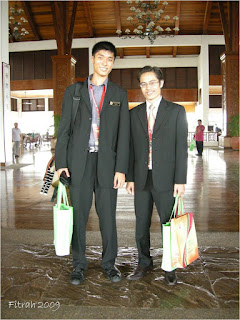
4 June: At the Alumni Conference for Excellence hosted by UPM this year, I discovered that a Victorian, Sabrie Salleh, made his mark in campus politics. He is the immediate past president of UPM's Student Council.

4 June: Sunset over the Mines.
The barbecue dinner that night was really something. The VIP table was vacant until occupied by latecomers. I vividly remember what the actual VIPs (all UPM alumni) said, referring to the serving trays in the centre of the table: "This table is for lazy people." They promptly sat themselves down at the other tables.

6 June: Jessica introduced me to Food Garden at The Gardens, the most peaceful and inviting food court I have ever seen.

9 June: Nigel picked up a Father's Day card for Mr Rode. It would travel with me on adventures to Kuala Pilah and Sekolah Sri Sempurna.

11 June: Dinner at the Bishop's, with his mother, sister Caryn, and sister's friend Hannah. It was splendid, though the onions roasted with the chicken seemed somwhat dehydrated!

16 June: Tan Sri Dr Koh Tsu Koon, at the Public Forum on Race Relations organised by KITA at the Malaysian Institute of Integrity.
He was rushing for a function at the UM, so it was apt that we, members of the Student Council, attended and stayed throughout the forum!

Marina and Sivin, after the forum.

17 June: The recently very popular teh tiga lapis (three-layered tea), comprising gula melaka (palm sugar) at the bottom, milk in the centre, and tea on top.
Tim, Fitrah and I dubbed it the Bangsa Malaysia tea.

16-19 June was the MPM's planning week for the Orientation and the coming semester. There were many late nights which, unfortunately, ended with quite a bang.
"Daddy's gonna pay for your crashed car," Bono says.
So it was that Father's Day this year was a reminder that I will most likely never be able to repay my father for all that he's done for me, except by paying it forward in the years to come.
Thank you, Dad.

26 May: Met up with Alissa for the second time, having picked her up from the Bangsar LRT station the day before. She was on the lookout for a digital compact camera; she has since decided on the RM1300 Fujifilm Finepix F200EXR, having at first considered it too pricey.
I generally recommend Canon cameras, but I think the Finepix F200EXR is easily the most promising digital compact around today. Of course, digital cameras come and go with more randomness than Malaysian politician deaths, so the best today may easily be superseded a few months down the road.
Film is still the best investment, if quality is paramount.

29 May: My primary school, Sekolah Kebangsaan Taman Segar. The place has since surrendered its serenity to the hustle and bustle of development.

2 June: The new café at the Faculty of Science. It is coming along well, but Fitrah and I think it is way to small to cater to the faculty's colossal population.

4 June: At the Alumni Conference for Excellence hosted by UPM this year, I discovered that a Victorian, Sabrie Salleh, made his mark in campus politics. He is the immediate past president of UPM's Student Council.

4 June: Sunset over the Mines.
The barbecue dinner that night was really something. The VIP table was vacant until occupied by latecomers. I vividly remember what the actual VIPs (all UPM alumni) said, referring to the serving trays in the centre of the table: "This table is for lazy people." They promptly sat themselves down at the other tables.

6 June: Jessica introduced me to Food Garden at The Gardens, the most peaceful and inviting food court I have ever seen.

9 June: Nigel picked up a Father's Day card for Mr Rode. It would travel with me on adventures to Kuala Pilah and Sekolah Sri Sempurna.

11 June: Dinner at the Bishop's, with his mother, sister Caryn, and sister's friend Hannah. It was splendid, though the onions roasted with the chicken seemed somwhat dehydrated!

16 June: Tan Sri Dr Koh Tsu Koon, at the Public Forum on Race Relations organised by KITA at the Malaysian Institute of Integrity.
He was rushing for a function at the UM, so it was apt that we, members of the Student Council, attended and stayed throughout the forum!

Marina and Sivin, after the forum.

17 June: The recently very popular teh tiga lapis (three-layered tea), comprising gula melaka (palm sugar) at the bottom, milk in the centre, and tea on top.
Tim, Fitrah and I dubbed it the Bangsa Malaysia tea.

16-19 June was the MPM's planning week for the Orientation and the coming semester. There were many late nights which, unfortunately, ended with quite a bang.
"Daddy's gonna pay for your crashed car," Bono says.
So it was that Father's Day this year was a reminder that I will most likely never be able to repay my father for all that he's done for me, except by paying it forward in the years to come.
Thank you, Dad.
A Visit to the Zoo Museum
UM hosted an entourage of students from cluster schools in the Klang Valley, Seremban and Ipoh from 11-13 June. During the 'camp', they paid a visit to the Zoological Museum, and I was able to join them on Friday 12 June.
It was a pleasant surprise to see boys from the VI!
* * *
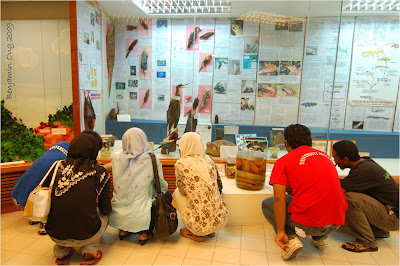
Facilitators glued to the displays.

Dr Sasekumar describing the skulls on display.

The insect collection.
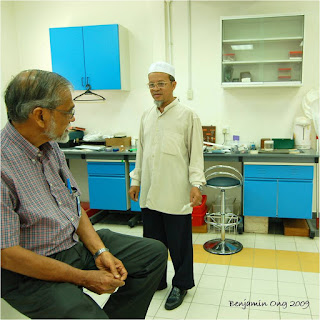
Living legends: Dr Sase and Pak Haji Mokhtar.

Siti Mazlina explaining the method of preparing pinned insect mounts.

Checking out the vertebrate collection on the highest floor.

Dr Sase and the tiger skin.

Dr Sase descending stairs.
* * *
The last picture was my favourite of the day, and it was an accident. Having forgotten to change the shutter speed as we exited the vertebrate floor, I shot it at 1/30 sec, f/4, ISO 200.
It probably exemplifies what Alissa means when she says I like taking decentralized portraits, with the subject off-centre.
I also realise I have a taste for extreme lighting.
And it is true what they say, that photography is about subtraction; about what you leave out often more so than what you include.
It was a pleasant surprise to see boys from the VI!
* * *

Facilitators glued to the displays.

Dr Sasekumar describing the skulls on display.

The insect collection.

Living legends: Dr Sase and Pak Haji Mokhtar.

Siti Mazlina explaining the method of preparing pinned insect mounts.

Checking out the vertebrate collection on the highest floor.

Dr Sase and the tiger skin.

Dr Sase descending stairs.
* * *
The last picture was my favourite of the day, and it was an accident. Having forgotten to change the shutter speed as we exited the vertebrate floor, I shot it at 1/30 sec, f/4, ISO 200.
It probably exemplifies what Alissa means when she says I like taking decentralized portraits, with the subject off-centre.
I also realise I have a taste for extreme lighting.
And it is true what they say, that photography is about subtraction; about what you leave out often more so than what you include.
Subscribe to:
Posts (Atom)
